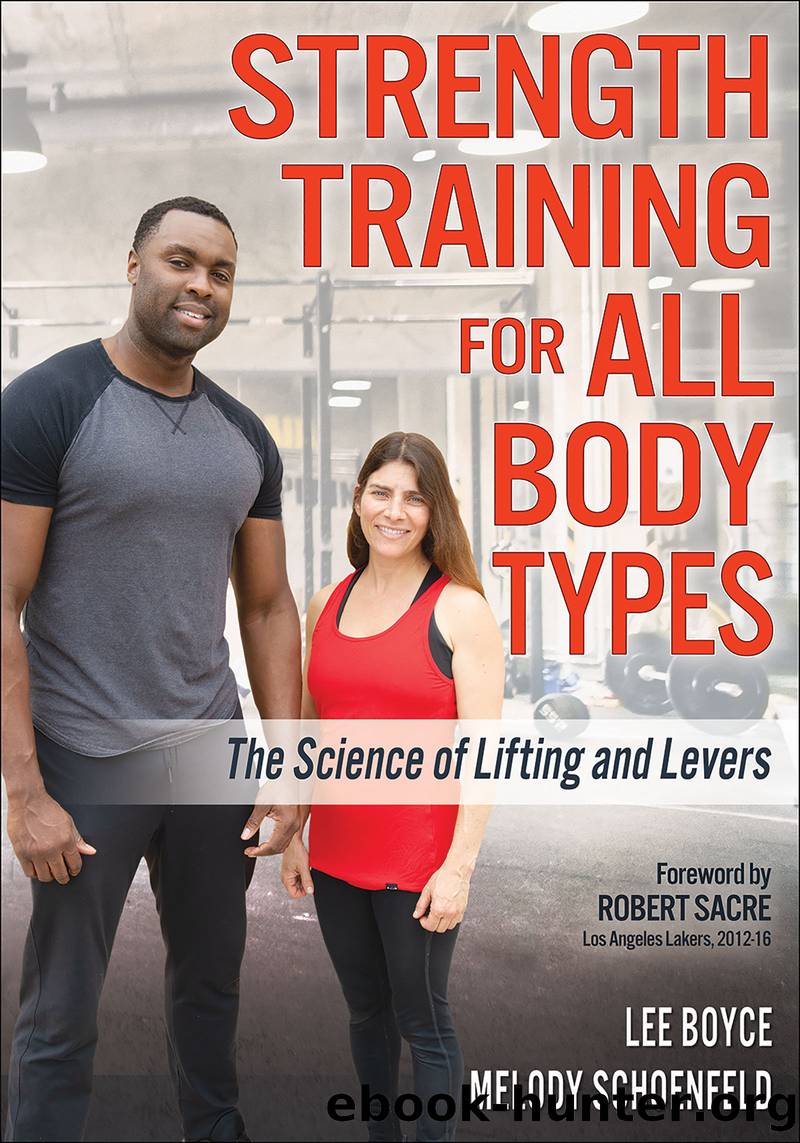Strength Training for All Body Types by Lee Boyce

Author:Lee Boyce
Language: eng
Format: epub
Publisher: Human Kinetics
Loop the free end of the bands around the barbell on whichever side of the plates the athlete prefers, as long as the bands are evenly placed on the bar. Test the press a few times before using the working weightâif the bands are pulling the bar off track, they will need to be adjusted so they are directly in line with the bar path (figure 7.6b).
Attaching stretch bands to the top of a power rack as opposed to the bottom provides the opposite stimulus of a traditional banded bench press in which the bands are affixed to the bottom of the rack. In this method, the bands support a portion of the barbellâs weight at the chest, and as the bar is pressed, it becomes heavier as the stretch is taken out of the bands. The amount of assistance provided by the bands depends on the thickness and age of the bands as well as the height of the rack to which they are attached.
This is another method longer-armed lifters can use to more safely overload a press, locking out a heavier weight than they could normally press from full range of motion. It is also a good way to generate more force through the sticking points of a press, much in the way as adding chains or bands to the bottom of the press. With chains or bands, the lifter can produce more force in the top of the lift with a heavier weight than otherwise possible (Swinton et al. 2011).
1.5-Repetition Bench Press
In the 1.5-repetition bench press, the lifter presses the bar halfway up, then returns it to the chest and performs a full-repetition bench press. The long-armed lifter in particular may benefit from this combination of partial- and full-range bench press for a few reasons:
The lifter will get extra lifting volume from the chest to about the sticking point in every lift. Training this portion of the bench press can increase strength in that specific range of motion (Newmire and Willoughby 2018). Having a particularly strong press off the chest will help propel the bar through the longer range of motion inherent in the long-armed athleteâs bench press.
The extra volume within each 1.5 repetitions can increase muscular endurance. As discussed earlier in this chapter, the long-armed lifter is more likely to fatigue in the bench press because of the distance the barbell needs to be pressed. The 1.5-repetition bench press is an excellent way to increase volume within a movement.
Combining partial range of motion lifts with full range of motion lifts has the potential to maximize muscle hypertrophy (Newmire and Willoughby 2018). You have learned in this chapter that a larger arm circumference and a larger body circumference are important for optimal bench press strength. The 1.5-repetition bench press is one mechanism that can be used to achieve more muscle mass.
Download
This site does not store any files on its server. We only index and link to content provided by other sites. Please contact the content providers to delete copyright contents if any and email us, we'll remove relevant links or contents immediately.
Periodization Training for Sports by Tudor Bompa(8103)
Bodyweight Strength Training by Jay Cardiello(7810)
Born to Run: by Christopher McDougall(7033)
Inner Engineering: A Yogi's Guide to Joy by Sadhguru(6641)
Asking the Right Questions: A Guide to Critical Thinking by M. Neil Browne & Stuart M. Keeley(5583)
The Fat Loss Plan by Joe Wicks(4764)
Bodyweight Strength Training Anatomy by Bret Contreras(4583)
Yoga Anatomy by Kaminoff Leslie(4253)
Science and Development of Muscle Hypertrophy by Brad Schoenfeld(4065)
Dynamic Alignment Through Imagery by Eric Franklin(4055)
ACSM's Complete Guide to Fitness & Health by ACSM(3943)
The Four-Pack Revolution by Chael Sonnen & Ryan Parsons(3913)
Exercise Technique Manual for Resistance Training by National Strength & Conditioning Association(3912)
Bodyweight Strength Training: 12 Weeks to Build Muscle and Burn Fat by Jay Cardiello(3883)
The Ultimate Bodybuilding Cookbook by Kendall Lou Schmidt(3860)
Yoga Anatomy by Leslie Kaminoff & Amy Matthews(3838)
American Kingpin by Nick Bilton(3720)
Yoga Therapy by Mark Stephens(3675)
Nutrition for Sport, Exercise, and Health by Spano Marie & Kruskall Laura & Thomas D. Travis(3671)
